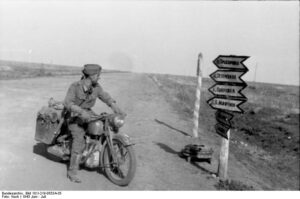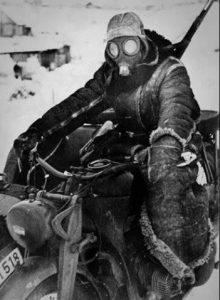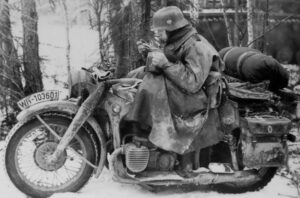 The German Kradmelder, motorcycle dispatch rider in English, could be used at any time in history, but in this case, they were used during World War II, specifically on the Eastern Front. The Eastern Front of World War II was a theatre of conflict between the European Axis powers against the Soviet Union (USSR), Poland and other Allies, which encompassed Central Europe, Eastern Europe, Northeast Europe (Baltics), and Southeast Europe (Balkans) from June 22, 1941 to May 9, 1945. The Soviet Union called it the Great Patriotic War, but everyone else called it the Eastern Front.
The German Kradmelder, motorcycle dispatch rider in English, could be used at any time in history, but in this case, they were used during World War II, specifically on the Eastern Front. The Eastern Front of World War II was a theatre of conflict between the European Axis powers against the Soviet Union (USSR), Poland and other Allies, which encompassed Central Europe, Eastern Europe, Northeast Europe (Baltics), and Southeast Europe (Balkans) from June 22, 1941 to May 9, 1945. The Soviet Union called it the Great Patriotic War, but everyone else called it the Eastern Front.
Dispatch riders were used by armed forces to get information from headquarters to the military units. They often didn’t have radios, and depending on the message, they might not have trusted the airwaves with some of the top secret messages. The Nazi Regime never really cared about its soldiers or its people, so the Kradmelder were sent out in the heat of summer or the frigid temperatures of winter. They were expendable, and that was all there was to it. Nevertheless, they played a vital role at a time when telecommunications were limited and insecure. They were also used to deliver carrier pigeons. The pigeons were used to send information back to headquarters, concerning the current situations on the front.
This type of dispatch was essential, but riding on an exposed vehicle in the Russian Winter, was brutal, and even deadly sometimes. During the winter the riders had better have protective clothing, or they could freeze to death.  The Kradfahrer (motorcycle rider) might wear a sentry’s fur-lined overcoat, heavy mittens, the fur-lined cap of the reversible winter suit, which is no doubt being worn beneath the overcoat, and a gas-mask for face protection…with the air filter canister removed from the gas-mask. Special extra eyepiece lens were issued for cold weather to prevent fogging by creating an airspace between the two lens.
The Kradfahrer (motorcycle rider) might wear a sentry’s fur-lined overcoat, heavy mittens, the fur-lined cap of the reversible winter suit, which is no doubt being worn beneath the overcoat, and a gas-mask for face protection…with the air filter canister removed from the gas-mask. Special extra eyepiece lens were issued for cold weather to prevent fogging by creating an airspace between the two lens.
In the summer, the German Kradmelder might wear his rubberized coat (Kradmantel) wrapped and buttoned around his legs to keep dirt and dust off his uniform. Personally, I can’t imagine wearing a rubberized coat in the summer simply to keep the dust off of a uniform. The rider would surly be melting from the heat, but the regime would require that the uniform be neat and clean at all times…even if it was soaked in sweat!! During World War II, the German military was the largest employers of motorcycles. On June 22, 1941 Germany launched its Operation Barbarossa, the 3-million-man invasion of the Soviet Union. The Kradmelder served a variety of functions including chauffeur service for officers, delivering dispatches, hot meals, as scouting patrols, as point vehicles taking the brunt of battle, sometimes as specially equipped tank destroyers. As with all motorcyclists, there was a kinship among these soldiers who called themselves “Kradmelder.” They bravely rode exposed without the armor plating of the Panzers Tanks and without the safety of hundreds of foot soldiers beside them. They were moving targets and sniper magnets. They never knew when they would encounter mine fields, artillery fire, and strafing aircraft, but they bravely went, because Hitler’s orders must be carried out…even if they died trying.
 Besides the known enemy, there was another enemy…the Russian weather. As Autumn approached, the roads had turned into nearly impassable bogs, the fields over which the motorcycles traveled turning in to “seas of jelly three feet more deep.” If that weren’t bad enough, Winter brought falling temperatures, often down to -40° Fahrenheit, causing engine oil and exposed soldiers froze solid. The “lucky” German Kradmelder benefited from special heating systems grafted onto their bikes, including foot and hand warmers. Still there were those who did not have these things, and even these things didn’t totally protect the rider. By the end of World War II, many if not most of the motorcycles, along with their riders, simply never returned home.
Besides the known enemy, there was another enemy…the Russian weather. As Autumn approached, the roads had turned into nearly impassable bogs, the fields over which the motorcycles traveled turning in to “seas of jelly three feet more deep.” If that weren’t bad enough, Winter brought falling temperatures, often down to -40° Fahrenheit, causing engine oil and exposed soldiers froze solid. The “lucky” German Kradmelder benefited from special heating systems grafted onto their bikes, including foot and hand warmers. Still there were those who did not have these things, and even these things didn’t totally protect the rider. By the end of World War II, many if not most of the motorcycles, along with their riders, simply never returned home.


One Response to The Kradmelder